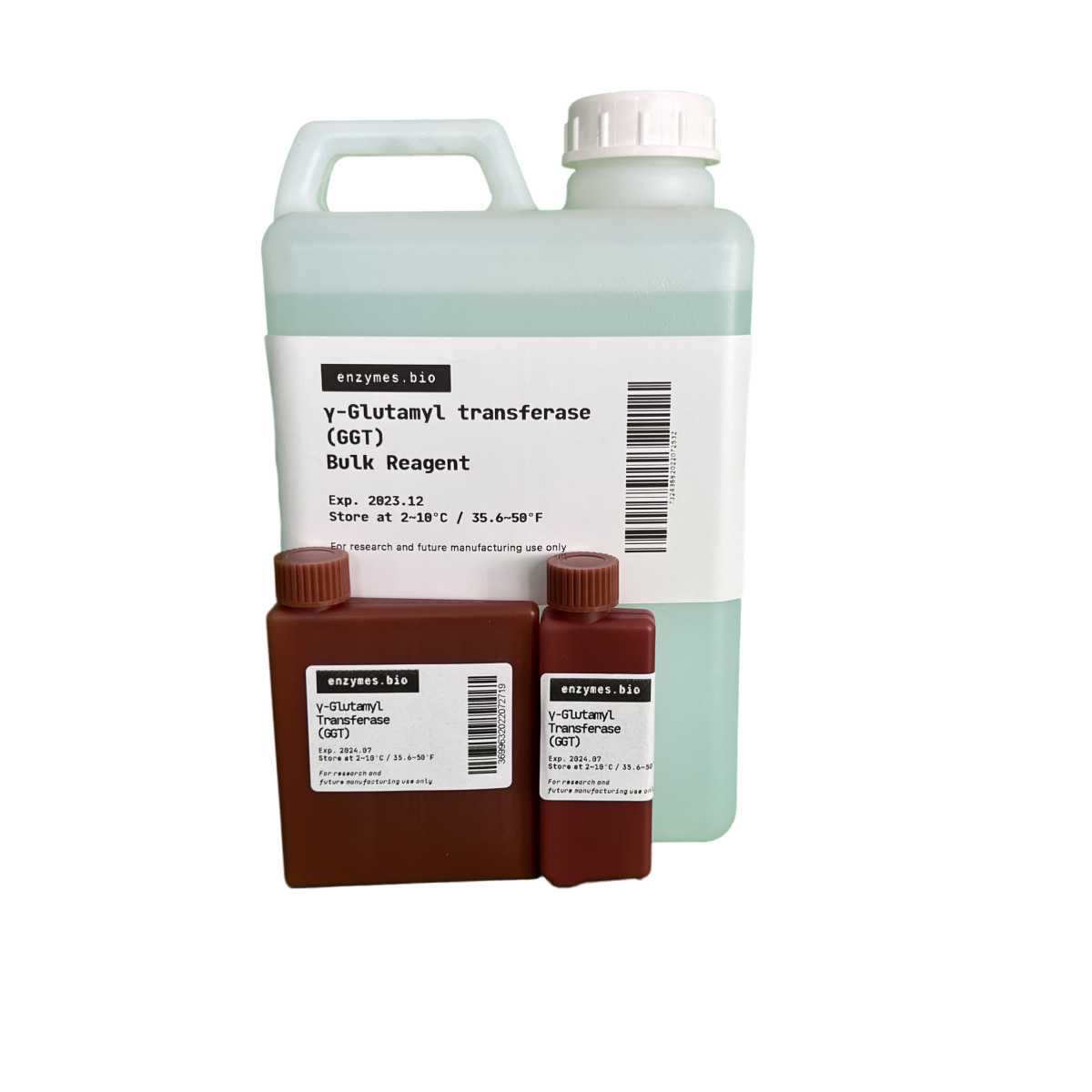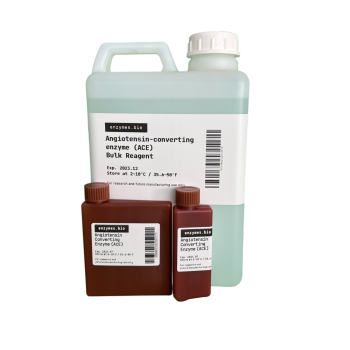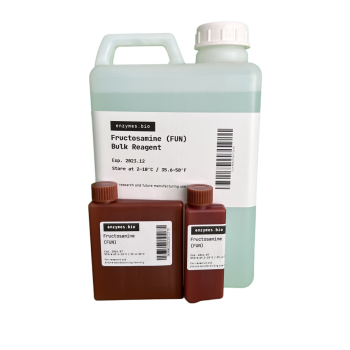Selling unit: per 100ml
Product Name
Common name: γ-glutamyl transferase (GGT) assay kit (IFCC rate method)
English name: GGT Reagent Kit (IFCC Kinetic Method)
Reagent Ratio
3:1,4:1,5:1 can be used, commonly used ratio 4:1.
Intended Use
This kit is used to determine the amount of GGT in human serum or plasma.
GGT is found in the kidney, pancreas, liver and prostate. GGT in the serum mainly originates from the liver and biliary system, therefore, its activity can be increased when there are liver and biliary diseases or injuries, such as obstructive jaundice, cholangitis and cholecystitis. The clinical diagnostic methods of GGT assay kits are mainly the rate method.
Test Principle
The method recommended by the International Federation of Clinical Chemistry (IFCC) was used. GGT in the sample catalyzed the transfer of glutamyl from the soluble substrate (L-γ-glutamyl-3-carboxy-4-nitroaniline sodium salt) to glycylglycine to form L-γ-glutamylglycine and yellow 5-amino-2-nitrobenzoate, which caused an increase in absorbance at 405 nm, and the reaction rate of the increase in absorbance was monitored continuously at 404 nm, and the reaction rate was The rate of increase in absorbance at 404 nm was monitored continuously and was proportional to the amount of GGT in the sample.
Main Components
Reagent components included in the product.
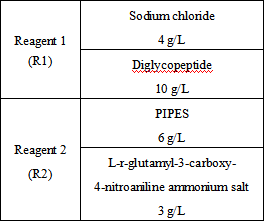
*Components are not interchangeable in kits with different lot numbers.
*Reagent components not included in the product, but necessary for the test: outsourced normal and abnormal QCs and calibrators.
Storage Conditions And Expiration Date
The kit is stored at 2-8°C away from light and is valid for one year.
Reagents that have been opened are taken care not to be contaminated and the reagents are stabilized in the instrument compartment (2-8°C) for one month.
The reagents must not be frozen.
Applicable Instruments
Hitachi 7180/7600; Olympus AU680/2700; Toshiba TBA120; Myriad BS2000M/480; Siemens ADVIA 1800/2400 series automatic biochemical analyzers.
Sample Request
Fresh serum or plasma (heparin or EDTA anticoagulation), serum specimens were stored at 4°C for one week to stabilize.
Test Method
- Reagent preparation: liquid reagents are ready to use out of the bottle.
- test conditions: (different test instruments can be requested according to the different parameters on the machine)
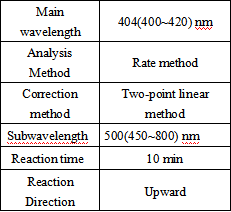
Operation steps.
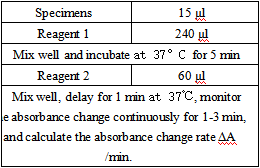
*Reagents and sample volumes can be increased or decreased in proportion to the requirements of different biochemical analyzers.
- Calibration procedure.
Randox calibration sera are recommended. γ-glutamyl-3 carboxy-4-nitroaniline (IFCC) 37°C is the method of choice for Randox calibration sera.
- QC control procedures.
It is recommended that each laboratory establish its own quality control system and select appropriate quality control products for quality control. The measured values of QC products should be within the specified range. If outside the specified range, it is necessary to take appropriate measures or contact the manufacturer.
- Calculation.
Sample concentration = (sample ΔA /min) / (standard ΔA /min) × standard concentration
Positive Judgment Value Or Reference Interval
Male: 11 to 50 U/L
Female: 7 to 32 U/L
It is recommended that each laboratory establish its own reference range of normal values.
Interpretation Of Test Results
The determination of GGT in serum or plasma is only one of the indicators used by the clinician to make a diagnosis of the patient. The clinician must also make a comprehensive judgment based on the patient’s physical symptoms, medical history, and other diagnostic items and diagnostic tools.
Limitations Of The Test Method
Ascorbic acid ≤ 30 mg/dL, bilirubin ≤ 40 mg/dL, hemoglobin ≤ 400 mg/dL, and celiac disease ≤ 500 mg/dL did not interfere with the determination.
Product Performance Index
Absorbance of reagent blank: wavelength 404 nm, optical diameter 1.0 cm, temperature 37°C, A0 ≤ 1.2.
Absorbance change rate of reagent blank: △A/min ≤ 0.005 at wavelength 404 nm and optical diameter 1.0 cm.
Analytical sensitivity: The kit tests 50 U/L of the test substance with absorbance change rate ΔA/min ≥ 0.005.
Linearity interval: test serum samples, reagent linearity in the interval of 5-700 U/L, linear correlation coefficient|r| should not be less than 0.990; in the interval of 5-50 U/L, the absolute deviation of linearity should not exceed 5 U/L; in the interval of (50-700 U/L, the relative deviation of linearity should not exceed ±10%.
Precision: repeatability CV ≤ 5%; relative extreme difference between batches ≤ 5%.
Accuracy: Relative deviation ≤ 10%.
Caution
- This product is used for in vitro diagnosis only.
- Avoid contamination when using the reagent, the container used must be clean, and please take necessary precautions, do not swallow, and avoid contact with skin and mucous membrane.
- Please dispose of the measured samples and waste liquids in accordance with the relevant national and local laws and regulations.
- Do not mix R1 and R2 into a single reagent for use.
- When changing the reagent lot number, please recalibrate.
Reference
- Thomas L. Clinical Laboratory Diagnostics. 1sted. rankfurt:TH-Books Verlagsgesellschaft;1998. p. 80-6.
- Persijn JP, van der Silk W. A new method for the determination of gamma-glutamyltransferase in serum.JClinChemClinBiochem 1976; 14:421-7
- Szasz G. Gamma-Glutamyltranspeptidase. In: Bergmeyer HU. Methoden der enzymatischenAnalyse. wein heim:VerlagChemie, 1974. p. 757.
- Schumann G, Bonora R, Ceriotti F, Férard G et al. IFCCprimari reference procedure for the measurement of catalytic activity concentrations of enzymes Part 5: Reference procedure for the measurement of catalytic concentration of gamma-glutamyltransferase. ClinChem Lab Med 2002; 40:734-8
